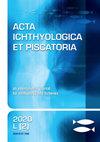Fish populations and biomass in headwater streams of the Lake Tumba Landscape, DR Congo, 2007–2011
IF 1
4区 农林科学
Q3 FISHERIES
引用次数: 0
Abstract
The fish biodiversity in the Congo River and its tributaries is extremely rich but the information on fish communities in the headwaters in terms of catch and biomass estimates is rare. Fishes in the running and stagnant waters in this region are of vital importance as a food resource for local residents. This study aimed to describe the fish community, catch, and biomass in the three headwater streams Bambou, Lebomo, and Bongo in the Lake Tumba Landscape (LTL) of the Democratic Republic of the Congo. Such information is of vital importance as a benchmark to understand the sustainability of the fish population for future generations of residents of the LTL. The field data were collected from 2007 through 2011, including dry and wet seasons. Here we present the results of this systematic, multi-annual study which was the first for fishes in streams of this region. In total, 50 species of 15 families were found in the nutrient-poor brown waters of these streams where high concentrations of humic acids cause a low pH. Among abundant species occurring in all three streams were the cyprinid Enteromius holotaenia (Boulenger, 1904), the mormyrid Marcusenius moorii (Günther, 1867), the alestids Clupeocharax schoutedeni Pellegrin, 1926 and Bryconaethiops boulengeri Pellegrin, 1900, and the clariid Clarias angolensis Steindachner, 1866. Bongo Stream was distinguished from the others by a rich abundance of Alestopetersius compressus (Poll et Gosse, 1963). The presence of several species at low pH (between 5.0 and 5.5) is new information that lowers the bottom of the pH interval for these species compared to earlier reports. The maximum total length (TL) of some other species was by 5–20 percentage points higher than those reported earlier. The median weight per unit effort (WPUE) in the streams varied between 30 and 115 g per hour during the dry seasons and between 18 and 86 g per hour during the wet seasons. The fish biomass in the streams varied between 0.05 and 0.7 g ⸱ m–2 with a median 0.14 g ⸱ m–2. This relatively low value compared to other tropical headwaters may be a result of the low pH and dark color of these headwaters. The results of the study serve as a reference point to which future monitoring of fish fauna can be compared for sustainable management of the LTL.Fish刚果民主共和国通巴湖景观源头溪流的种群和生物量,2007-2011
刚果河及其支流的鱼类生物多样性极其丰富,但关于源头鱼类群落的渔获量和生物量估计的信息却很少。该地区活水和死水中的鱼类是当地居民至关重要的食物资源。本研究旨在描述刚果民主共和国通巴湖景观(LTL)三条源头溪流Bambou、Lebomo和Bongo的鱼类群落、捕捞量和生物量。这些信息对于了解LTL后代居民鱼类种群的可持续性至关重要。现场数据从2007年到2011年收集,包括旱季和雨季。在这里,我们介绍了这项系统的、多年的研究结果,这是该地区溪流中鱼类的第一次研究。在这些水体中,由于高浓度的腐殖酸导致ph值较低,在营养贫乏的褐色水体中共发现了15科50种。在所有三条河流中都有丰富的物种,包括鲤科Enteromius holotaenia (Boulenger, 1904), mormyrid Marcusenius moorii (g nther, 1867), alestids Clupeocharax schoutedeni Pellegrin(1926)和Bryconaethiops boulengeri Pellegrin(1900),以及Clarias angolensis Steindachner(1866)。邦戈河与其他河流的区别在于其丰富的Alestopetersius compressus (Poll et Gosse, 1963)。与之前的报道相比,一些物种在低pH值(5.0到5.5之间)的存在是降低这些物种pH区间底部的新信息。其他一些物种的最大总长度(TL)比先前报道的高5-20个百分点。在旱季,每单位努力的中位数重量(WPUE)在每小时30至115克之间变化,在雨季在每小时18至86克之间变化。鱼类生物量变化范围为0.05 ~ 0.7 g⸱m-2,中位数为0.14 g⸱m-2。与其他热带水源相比,这种相对较低的值可能是由于这些水源的pH值较低和颜色较深。研究结果可作为未来鱼类区系监测的参考点,以供比较鱼类区系的可持续管理。
本文章由计算机程序翻译,如有差异,请以英文原文为准。
求助全文
约1分钟内获得全文
求助全文
来源期刊

Acta Ichthyologica Et Piscatoria
FISHERIES-ZOOLOGY
CiteScore
2.20
自引率
0.00%
发文量
31
审稿时长
>12 weeks
期刊介绍:
ACTA ICHTHYOLOGICA ET PISCATORIA (AIeP) is an international, peer-reviewed scientific journal that publishes articles based on original experimental data or experimental methods, or new analyses of already existing data, in any aspect of ichthyology and fisheries (fin-fish only).
 求助内容:
求助内容: 应助结果提醒方式:
应助结果提醒方式:


